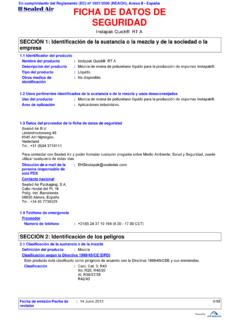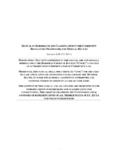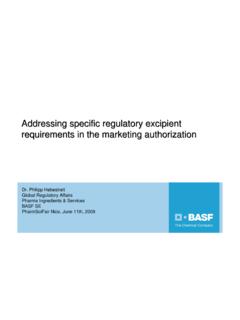Transcription of SAFETY DATA SHEET - Sealed Air: Sustainable, …
1 Instapak Quick RT BProduct nameConforms to Regulation (EC) No. 1907/2006 (REACH), Annex II, as amended by Regulation (EU) No. 453/2010 -United Kingdom (UK):Not means of Product type:Product description:Polyether Polyol Resin Mixture for the production of Instapak polyurethane packaging Relevant identified uses of the substance or mixture and uses advised againstSECTION 1: Identification of the substance/mixture and of the company/undertakingProduct code:Not DATA SHEETI nstapak Quick RT Details of the supplier of the SAFETY data sheete-mail address of person responsible for this SDS:National contactSealed Air 456545 AH Nijmegen,NederlandTel.: +31 (0)24 3710111To contact Sealed Air with your Environmental, Health and SAFETY questions please Air Limited,Telford Way, Kettering, Northants NN16 8UN England,Telephone: 01536 315700 Fax: 01536 410576 Emergency telephone numberNational advisory body/Poison Centre:Telephone numberSupplierTelephone number:+31(0) 24 37 10 164 ( - CET)Call 111 if you urgently need medical help or advice but it's not a life-threatening situation (NHS 111 service).
2 In Cornwall, the Scilly Isles, Luton and Bedfordshire areas call 0845 4647 (NHS Direct).For immediate, life-threatening emergencies, call 999 (Emergency and urgent care services).Product use:Polyether Polyol Resin mixture for use in Instapak foam dispensing equipmentIndustrial applications.:Area of applicationDate of issue/Date of revision:Date of previous issue:Version:11/1423/04/2015No previous validationConforms to Regulation (EC) No. 1907/2006 (REACH), Annex II, as amended by Regulation (EU) No. 453/2010 -United Kingdom (UK)Instapak Quick RT B:Other hazards which do not result in classificationNone Section 11 for more detailed information on health effects and according to Regulation (EC) No. 1272/2008 [CLP/GHS]30 percent of the mixture consists of component(s) of unknown toxicityContains % of components with unknown hazards to the aquatic environmentSECTION 2: Hazards Classification of the substance or mixtureProduct definition:Mixture (Mixture present inside the article)See Section 16 for the full text of the H statements declared of unknown toxicity:Ingredients of unknown Label elementsHazard pictograms:Signal word:Hazard statements:Prevention:Precautionary statementsResponse:Storage:Disposal:Warn ingH319 - Causes serious eye - Wear eye - Wash hands thoroughly after + P351 + P338 - IF IN EYES: Rinse cautiously with water for several contact lenses, if present and easy to do.
3 Continue + P313 - If eye irritation persists: Get medical label elementsContainers to be fitted with child-resistant fasteningsNot warning of dangerNot applicable.:::Not packaging requirementsHazardous ingredients:Tertiary Other hazardsEye Irrit. 2, H319 Annex XVII - Restrictions on the manufacture,placing on the market and use of certain dangerous substances, mixtures and articles:Not product is classified as hazardous according to Regulation (EC) 1272/2008 as of issue/Date of revision:Date of previous issue:Version:12/1423/04/2015No previous validationConforms to Regulation (EC) No. 1907/2006 (REACH), Annex II, as amended by Regulation (EU) No. 453/2010 -United Kingdom (UK)Instapak Quick RT BOccupational exposure limits, if available, are listed in Section nameThere are no additional ingredients present which, within the current knowledge of the supplier and in the concentrations applicable, are classified as hazardous to health or the environment, are PBTs, vPvBs or Substances of equivalent concern, or have been assigned a workplace exposure limit and hence require reporting in this 3: Composition/information on ingredients2-[2-(dimethylamino)ethoxy]et hanolEC: 216-940-1 CAS: 1704-62-7 3 - <5 Acute Tox.
4 4, H312 Skin Corr. 1C, H314 Eye Dam. 1, H318[1]%TypeRegulation (EC) No. 1272/2008 [CLP]ClassificationSee Section 16 for the full text of the H statements declared above.[1] Substance classified with a health or environmental hazard[2] Substance with a workplace exposure limit[3] Substance meets the criteria for PBT according to Regulation (EC) No. 1907/2006, Annex XIII[4] Substance meets the criteria for vPvB according to Regulation (EC) No. 1907/2006, Annex XIII[5] Substance of equivalent Mixtures:Mixture (Mixture present inside the article)Wash out mouth with water. Remove dentures if any. Remove victim to fresh air and keep at rest in a position comfortable for breathing. If material has been swallowed and the exposed person is conscious, give small quantities of water to drink. Stop if the exposed person feels sick as vomiting may be dangerous. Do not induce vomiting unless directed to do so by medical personnel. If vomiting occurs,the head should be kept low so that vomit does not enter the lungs.
5 Get medical attention if adverse health effects persist or are severe. Never give anything by mouth to an unconscious person. If unconscious, place in recovery position and get medical attention immediately. Maintain an open airway. Loosen tight clothing such as a collar, tie, belt or contactImmediately flush eyes with plenty of water, occasionally lifting the upper and lower eyelids. Check for and remove any contact lenses. Continue to rinse for at least 10 minutes. Get medical contaminated skin with plenty of water. Remove contaminated clothing and shoes. Get medical attention if symptoms occur. Wash clothing before shoes thoroughly before Description of first aid measuresRemove victim to fresh air and keep at rest in a position comfortable for not breathing, if breathing is irregular or if respiratory arrest occurs, provide artificial respiration or oxygen by trained personnel. It may be dangerous to the person providing aid to give mouth-to-mouth resuscitation.
6 Get medical attention if adverse health effects persist or are severe. If unconscious, place in recovery position and get medical attention immediately. Maintain an open airway. Loosen tight clothing such as a collar, tie, belt or waistband. In case of inhalation of decomposition products in a fire, symptoms may be delayed. The exposed person may need to be kept under medical surveillance for 48 contact::::Protection of first-aiders:No action shall be taken involving any personal risk or without suitable training. It may be dangerous to the person providing aid to give mouth-to-mouth 4: First aid Most important symptoms and effects, both acute and delayedPotential acute health effectsCauses serious eye irritation.:Eye contactDate of issue/Date of revision:Date of previous issue:Version:13/1423/04/2015No previous validationConforms to Regulation (EC) No. 1907/2006 (REACH), Annex II, as amended by Regulation (EU) No. 453/2010 -United Kingdom (UK)Instapak Quick RT BSECTION 4: First aid measuresNotes to physicianIn case of inhalation of decomposition products in a fire, symptoms may be exposed person may need to be kept under medical surveillance for 48 hours.
7 :Specific treatmentsInhalation:No known significant effects or critical known significant effects or critical hazards.:IngestionSkin contact:No known significant effects or critical signs/symptomsSkin contactIngestionInhalationNo specific specific specific data.:::Eye contact:Adverse symptoms may include the following:pain or Indication of any immediate medical attention and special treatment neededNo specific treatment.:SECTION 5: Firefighting measuresPromptly isolate the scene by removing all persons from the vicinity of the incident if there is a fire. No action shall be taken involving any personal risk or without suitable thermal decomposition productsHazards from the substance or mixtureDecomposition products may include the following materials:carbon dioxidecarbon monoxidenitrogen oxidesIn a fire or if heated, a pressure increase will occur and the container may should wear appropriate protective equipment and self-contained breathing apparatus (SCBA) with a full face-piece operated in positive pressure mode.
8 Clothing for fire-fighters (including helmets, protective boots and gloves)conforming to European standard EN 469 will provide a basic level of protection for chemical protective equipment for fire-fightersUse dry chemical, CO , water spray (fog) or Extinguishing media:::Do not use water extinguishing media:Unsuitable extinguishing Special hazards arising from the substance or Advice for firefightersSpecial protective actions for fire-fighters:SECTION 6: Accidental release Personal precautions, protective equipment and emergency proceduresFor non-emergency personnel:No action shall be taken involving any personal risk or without suitable surrounding areas. Keep unnecessary and unprotected personnel from entering. Do not touch or walk through spilt material. Avoid breathing vapour or mist. Provide adequate ventilation. Wear appropriate respirator when ventilation is inadequate. Put on appropriate personal protective of issue/Date of revision:Date of previous issue:Version:14/1423/04/2015No previous validationConforms to Regulation (EC) No.
9 1907/2006 (REACH), Annex II, as amended by Regulation (EU) No. 453/2010 -United Kingdom (UK)Instapak Quick RT BSECTION 6: Accidental release Environmental precautionsStop leak if without risk. Move containers from spill area. Approach the release from upwind. Prevent entry into sewers, water courses, basements or confined areas. Wash spillages into an effluent treatment plant or proceed as and collect spillage with non-combustible, absorbent material sand,earth, vermiculite or diatomaceous earth and place in container for disposal according to local regulations. Dispose of via a licensed waste disposal absorbent material may pose the same hazard as the spilt dispersal of spilt material and runoff and contact with soil, waterways, drains and sewers. Inform the relevant authorities if the product has caused environmental pollution (sewers, waterways, soil or air).Large spill:Stop leak if without risk. Move containers from spill area. Dilute with water and mop up if water-soluble.
10 Alternatively, or if water-insoluble, absorb with an inert dry material and place in an appropriate waste disposal container. Dispose of via a licensed waste disposal Methods and material for containment and cleaning upFor emergency Reference to other sectionsSee Section 1 for emergency contact Section 8 for information on appropriate personal protective Section 13 for additional waste treatment specialised clothing is required to deal with the spillage, take note of any information in Section 8 on suitable and unsuitable materials. See also the information in "For non-emergency personnel".::Store between the following temperatures: 10 to 40 C (50 to 104 F). Store in accordance with local in original container protected from direct sunlight in a dry, cool and well-ventilated area, away from incompatible materials (see Section 10) and food and drink. Keep container tightly closed and Sealed until ready for use. Containers that have been opened must be carefully resealed and kept upright to prevent leakage.








